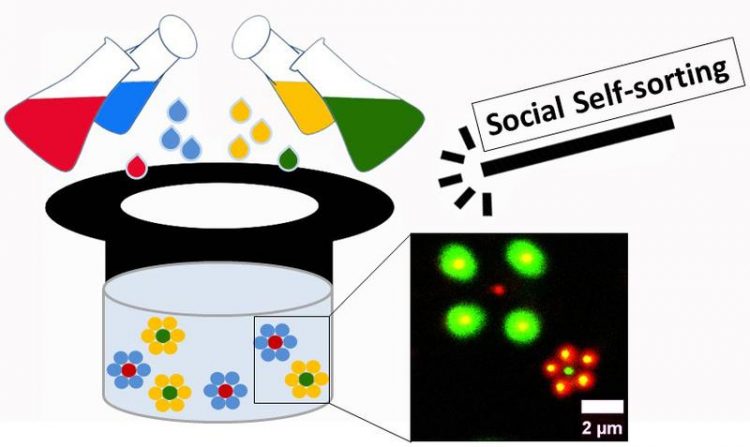Simulating cellular sorting processes

Scientists synthesized four kinds of gel particles, which can co-assemble into different objects. The illustration visualizes this process using colored droplets. Andreas Walther, University of Freiburg
Researchers from the DWI – Leibniz Institute for Interactive Materials in Aachen and the University of Freiburg now developed a set of four different, micrometer-sized building blocks, which can self-sort and co-assemble into defined compositions and disassemble at the push of a button.
A set of blue, red, green and yellow Lego bricks helps to visualize this research approach. It is very simple to build a multicolored object from these bricks, without considering the colors of the single bricks. To make it slightly more complicated, one could initially sort the bricks by their color and then build objects that are either blue, red, green or yellow.
Such processes are referred to as ‘unsocial assemblies’ if they are driven by themselves. To make things even more complex, you could also build some objects from red and blue bricks and others from green and yellow bricks. These processes, if running simultaneously, are termed ‘social assemblies’.
The scientists from Aachen and Freiburg solved a similar task; however on a microscopic scale by using small gel particles instead of Lego bricks. These so-called microgels are water-rich, sponge-like gel particles, which can be chemically modified.
“We used four different types of microgels for our experiments. The microgels can self-assemble in an ‘unsocial’ manner, staying amongst themselves, or co-assemble in a ‘social’ manner, with a second type of microgel,” explains Dr. Alexander Kühne from DWI. He coordinated this project together with Prof. Dr. Andreas Walther, a former DWI scientist who recently moved to the University of Freiburg.
The challenge of this project was to enable the microgels to distinguish between right and wrong partners. To achieve this, the scientists integrated molecular interactions so that only specific types of microgels would interact with each other – just like a key, which can only open a very specific lock.
However, instead of keys and locks, the researchers applied switchable molecules that integrate into cyclic sugar moieties. Triggered by certain chemical conditions or by light the researchers could control the molecular shape and their interactions during the experiment. This way, the microgels can self-sort, self-assemble and disassemble at the push of a button.
“We use these types of experiments to get a better understanding of processes running in natural cells,” says Alexander Kühne. “In addition, progress in this field of research will eventually help us to develop biologically inspired, interactive materials.”
Publication: Kang Han, Dennis Go, Thomas Tigges, Khosrow Rahimi, Alexander J. C. Kuehne, Andreas Walther, “Social Self-Sorting of Colloidal Families in Co-Assembling Microgel Systems”, Angewandte Chemie International Edition 2017, DOI: 10.1002/anie.201612196.
Media Contact
More Information:
http://www.dwi.rwth-aachen.deAll latest news from the category: Life Sciences and Chemistry
Articles and reports from the Life Sciences and chemistry area deal with applied and basic research into modern biology, chemistry and human medicine.
Valuable information can be found on a range of life sciences fields including bacteriology, biochemistry, bionics, bioinformatics, biophysics, biotechnology, genetics, geobotany, human biology, marine biology, microbiology, molecular biology, cellular biology, zoology, bioinorganic chemistry, microchemistry and environmental chemistry.
Newest articles

A ‘language’ for ML models to predict nanopore properties
A large number of 2D materials like graphene can have nanopores – small holes formed by missing atoms through which foreign substances can pass. The properties of these nanopores dictate many…

Clinically validated, wearable ultrasound patch
… for continuous blood pressure monitoring. A team of researchers at the University of California San Diego has developed a new and improved wearable ultrasound patch for continuous and noninvasive…

A new puzzle piece for string theory research
Dr. Ksenia Fedosova from the Cluster of Excellence Mathematics Münster, along with an international research team, has proven a conjecture in string theory that physicists had proposed regarding certain equations….



